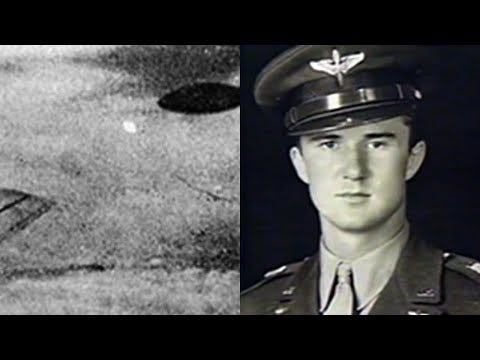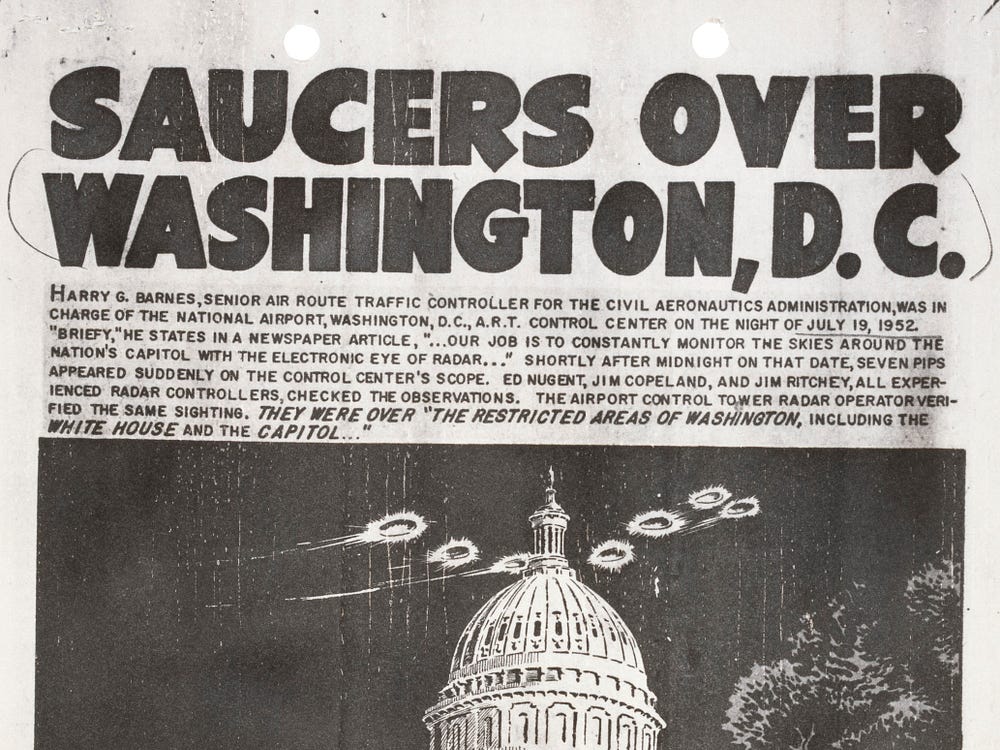UFO Conflict in the Skies
From official Government declassified documents, to pilot reports, there are cases which have made Air Force brass sit up and pay close attention.
In this episode of Tales of the Strange and Unexplained below.
▶️ Watch UFO Conflict in the Skies here
The Gorman UFO Incident 1948
In UFO history, the Gorman UFO Incident of 1948 stands out as a remarkable encounter between a pilot and an unexplained aerial phenomenon. On the evening of October 1, 1948, near Fargo, North Dakota, George F. Gorman, a 25-year-old lieutenant in the North Dakota Air National Guard, experienced what would become one of the early significant post-World War II UFO sightings. Flying his P-51 Mustang, Gorman noticed a peculiar ball of light exhibiting extraordinary maneuverability and speed, prompting him to engage in a high-speed chase that showcased the object’s baffling flight characteristics.

The pursuit, lasting approximately 27 minutes and at one point, the object and Gorman’s plane nearly collided, only for the UFO to execute a steep, abrupt climb, leaving Gorman and his aircraft trailing. The incident, thoroughly investigated by the U.S. Air Force’s Project Sign, drew initial explanations ranging from a lighted weather balloon to the planet Jupiter. However, Gorman, alongside several witnesses including air-traffic controllers Lloyd D. Jensen and H.E. Johnson, who were manning the Hector Airport tower and pilot Dr. A. E. Cannon, firmly disputed these explanations, underscoring the object’s uncharacteristic flight behavior and rapid movements that defied conventional understanding.
The Pilot who Died Chasing a UFO
On January 7, 1948, Captain Thomas F. Mantell, a Kentucky Air National Guard pilot, met his untimely demise while in pursuit of what he believed was an UFO. The incident unfolded over the skies of Kentucky, climaxing with Mantell’s P-51 Mustang fighter plane crashing near Franklin.

Mantell’s pursuit began following a report from the Kentucky State Police to Godman Army Airfield about an unusual object in the sky. Tasked with investigating, Mantell, flying nearby, engaged the object, describing it as metallic and of enormous size. His chase reached an altitude of 25,000 feet, where, without oxygen equipment, he succumbed to hypoxia, resulting in a fatal crash. The incident was thoroughly examined by the U.S. Air Force’s Project Sign, the forerunner to the renowned Project Blue Book, sparking widespread speculation regarding the nature of the object, from Venus to secret government projects.
Subsequent revelations, particularly through declassified documents, pointed to the Skyhook project — a classified Navy initiative involving high-altitude balloons for atmospheric radiation data collection — as the likely explanation for the object Mantell chased. This re-examination, led by Captain Edward Ruppelt of Project Blue Book in the 1950s, shed light on the misidentification that led to Mantell’s tragic ascent without adequate oxygen. His death marked the first flight casualty of the Kentucky Air National Guard.
UFOs over Washington D.C.
Shortly before midnight on July 19,1952, at Washington National Airport (now Ronald Reagan Washington National Airport), air traffic controller Edward Nugent spotted seven unidentified objects on radar to the southwest of the city. Nugent’s observations were quickly corroborated by his colleagues, confirming the radar’s accuracy and the unusual nature of the objects’ flight patterns. Intriguingly, these luminous objects were also detected over critical landmarks, including the White House and the Capitol Building.

The situation escalated in the early hours of July 20, as fighter jets from New Castle Air Force Base in Delaware were scrambled to intercept the mysterious objects. However, the UFOs vanished from radar and visual observation as the jets neared Washington, only to reappear once the aircraft were en route back to base due to low fuel. This cat-and-mouse game continued into the following weekend, with another sighting on July 26 involving a commercial flight crew and subsequent radar confirmations of multiple UFOs, leading to another fruitless pursuit by fighter jets. The pilots quickly discovered that the UFOs’ velocity far exceeded the capabilities of his aircraft, forcing him to abandon the chase. The incidents prompted President Harry S. Truman to request a briefing from Project Blue Book.
The official explanation for the incidents, attributing the radar sightings to temperature inversions, was later criticized by Captain Edward Ruppelt, the head of Project Blue Book, who argued that such inversions were known radar anomalies and could not account for what was observed in Washington D.C.
Iran’s Most Famous UFO Encounter

In the early hours of September 19, 1976, the skies over Tehran, Iran, became the stage for one of the most compelling UFO encounters of the 20th century. Triggered by civilian reports of unusual lights, the Imperial Iranian Air Force (IIAF) scrambled an F-4 Phantom II jet to investigate the anomaly. This decision set in motion a series of events that would leave a lasting imprint on UFO studies and military records alike.
The initial sortie ended in confusion as the first F-4 pilot faced sudden instrumentation and communication failures, compelling a premature return to base. Unperturbed, the IIAF dispatched a second F-4, piloted by Lieutenant Parviz Jafari, who managed to approach the mysterious object. Jafari’s encounter with the UFO was marked by vivid descriptions of the object’s luminescence and its ability to emit rapidly changing lights in hues of blue, green, red, and orange. The situation intensified when Jafari’s attempts to engage the object with an AIM-9 missile were thwarted by a sudden and unexplained malfunction of his weapons control panel, coupled with a brief loss of communication with ground control.
The encounter reached its climax as a smaller object detached from the UFO, hurtling directly towards Jafari’s aircraft and forcing him to execute evasive maneuvers. Miraculously, the smaller object then returned to the main UFO before both disappeared from sight, leaving behind a bewildered pilot and a fully functional jet.
Read the full Iran’s Famous and Documented UFO Encounter here.
The Pilot who Chased a UFO and Disappeared
On October 21, 1978, Frederick Valentich, a 20-year-old Australian pilot with 150 hours of experience, took off from Moorabbin Airport near Melbourne, Victoria. He was flying his Cessna 182L towards King Island across the Bass Strait, an event that would soon place him at the center of a notable UFO case. Despite his experience, nothing could have prepared him for the extraordinary events of that night.

Approximately 45 minutes into his flight, at 7:06 PM, Valentich initiated a perplexing communication with Melbourne air traffic control. He inquired about any aircraft at his altitude, to which he was informed there was none. Valentich then reported an encounter with an unidentified aircraft, describing it as possessing four bright lights and an extraordinary appearance, seemingly toying with him by orbiting above and maneuvering at high speeds in various directions. His final, chilling transmission, “It is hovering, and it’s not an aircraft,” was followed by 17 seconds of a metallic scraping sound, then silence.
The aftermath of Valentich’s disappearance involved a comprehensive search across the Bass Strait, yet neither he nor his aircraft were ever recovered. The Australian Department of Transport led an investigation that ultimately could not shed light on the nature of the unidentified object or the circumstances behind Valentich’s vanishing.
A Landmark in Modern UFO Sightings
The 2004 USS Nimitz UFO encounter, colloquially known as the “Tic Tac” incident, represents a seminal event in modern UAP sightings. This well-documented encounter occurred off the coast of San Diego, California, during a routine training exercise by the USS Nimitz Carrier Strike Group. The sighting was brought to public attention when fighter pilots, operating F/A-18 Super Hornets, were dispatched to investigate radar anomalies detected by the USS Princeton. These anomalies had been under observation for several days, depicting behaviors far beyond the known capabilities of existing aircraft.

Central to this encounter were Commander David Fravor and Alex Deitrich, who reported observing an object resembling a “Tic Tac,” approximately 40 feet in length, displaying extraordinary aerodynamic capabilities. The object was seen hovering above an ocean disturbance before rapidly ascending, executing maneuvers and accelerations that defy conventional understanding, all without visible propulsion. When Fravor attempted to close in, the object vanished from sight in seconds, only to reappear 60 miles away, as detected by radar shortly thereafter.
The significance of this event was further underscored by the Pentagon’s official confirmation on April 27, 2020, of the authenticity of the “Gimbal” and “Go Fast” footage, alongside the initial “Tic Tac” video. These videos, capturing UAPs performing maneuvers contrary to known aircraft capabilities, were acknowledged as genuine depictions of unidentified aerial phenomena. This acknowledgment, facilitated by To the Stars Academy of Arts and Sciences and highlighted by The New York Times back in December 2017 and March 2018, marked a pivotal moment in U.S. government transparency regarding UAP encounters. The Pentagon’s confirmation on April 27, 2020 sought to address public speculation and affirm the reality of these unexplained phenomena. This was also one of the first times the U.S. government officially recognized the existence of unidentified aerial phenomena captured on video by military pilots.
Access all of Cristina Gomez’ links — click here

Comments & Upvotes